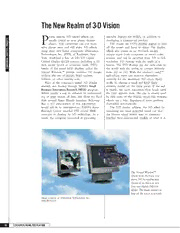Table Of ContentThe New Realm of 3-D Vision
P
eople seeking 3-D special effects are specialty displays for NASA, in addition to
S
F usually forced to wear plastic shutter developing a commercial product.
F
O
N glasses. Now consumers can put those The images on DTI’s displays appear to leap
PI
—S retro glasses away and still enjoy 3-D effects off the screen and hang in space. The display,
S
FIT using their own home computers. Dimension which also comes in an 18.1-inch model,
E
N Technologies Inc. (DTI), of Rochester, New accepts input from computers or stereo video
E
B
L York, developed a line of 2-D/3-D Liquid sources, and can be switched from 3-D to full-
A
CI Crystal Display (LCD) screens, including a 15- resolution 2-D viewing with the push of a
R
E
M inch model priced at consumer levels. DTI’s button. The DTI displays are the only ones in
M
CO family of flat panel LCD displays, called the the world with the ability to convert instantly
Virtual Window,™ provide real-time 3-D images from 3-D to 2-D. With the product’s eyeQ™
without the use of glasses, head trackers, technology, users can position themselves
helmets, or other viewing aids. correctly for the maximum 3-D effect. EyeQ
Most of the company’s initial 3-D display works by placing a small red LED (light
research was funded through NASA’s Small emitting diode) on the front panel. If the red
Business Innovation Research (SBIR) program. is visible, the users reposition their heads until
NASA sought a way to enhance its understand- the LED appears dark. The cue is mostly used
ing of great masses of data, like those for fluid by new users of the display, much like training
flow around Space Shuttle launches. Believing wheels on a bike. Experienced users position
that a 3-D presentation of this information themselves automatically.
would aid in its interpretation, NASA’s Ames The DTI display achieves the 3-D effect by
Research Center awarded DTI several SBIR simulating the most powerful visual cue that
contracts to develop its 3-D technology. As a the human visual system uses to construct
result, the company succeeded in providing internal three-dimensional models of what it is
The Virtual Window™
system tricks the brain into
seeing 3-D by creating two
images of an object as seen
from two slightly different
angles. The image appears to
leap off the screen as a result.
Image courtesy of Dimension Technologies Inc.,
www.dti3d.com
92 CONSUMER/HOME/RECREATION
seeing. This cue, called binocular disparity,
S
gives viewers the vivid sensation of depth that DTI’s flat panel LCD FF
O
is only seen when looking at the real world or displays provide 3-D PIN
a 3-D movie. Binocular disparity is the slight images without any —S
S
difference between what the left eye sees and special viewing aids. FIT
E
what the right eye sees. Because left and right N
E
B
eyes look at the world from two slightly L
A
different locations, about 2.5 inches apart on RCI
E
average, the shape of an object seen by each M
M
eye is slightly dissimilar, as is the way the two CO
images of the object line up with one another.
A person experiences this disparity by looking
at an object with only one eye and then the
other. The brain processes the differences in
these two views to provide an accurate repre- Image courtesy of
sentation of the three-dimensional shape and Dimension Technologies
position of the object, resulting in the real Inc., www.dti3d.com
depth 3-D humans see in the real world.
The DTI system fools the brain into seeing
real depth by creating two images of a scene
as seen from two slightly different viewing
angles. It then takes one image and displays it Microsoft,® Northrop Grumman, Honeywell,
on the odd pixel columns of a LCD screen, Lockheed Martin, Kodak, all branches of the
while placing the other image on the even military, Massachusetts Institute of Technology
columns. Thin light sources behind the screen (MIT), Stanford, Johns Hopkins, and about 40
send light through the odd and even columns, other worldwide educational institutions. The
which travels out at slightly different angles technology greatly benefits the medical field, as
toward the viewer. Since the different light surgical simulators, which allow virtually unlim-
sources only reach the corresponding left or ited practice with open surgical techniques, are
right eye, each eye only sees one of the helping to increase the skills of surgical resi-
images. The brain blends the two images into dents. DTI believes that the screens will gain
one, creating an image that appears to float in increased use as new software, more powerful
space in front of the flat panel screen. desktop PCs, and increased production quanti-
Adding real depth information to any presenta- ties drive down costs. DTI is actively seeking
tion makes the information easier and faster licensing partners to incorporate the unique
to understand. 3-D technology into their flat panel displays,
The Virtual Window displays have applica- thereby increasing production and decreasing
tions in data visualization, medicine, architec- costs. 3-D technology in everyday use may be
ture, business, real estate, entertainment, and closer than it looks! ❖
dozens of other research, design, military, and
consumer applications. Displays are currently Virtual Window™ is a trademark of Dimension
used for computer games, protein analysis, and Technologies Inc.
surgical imaging, to name just a few. Hundreds Microsoft® is a registered trademark of Microsoft
Corporation.
of worldwide users include NASA, Goodyear,
CONSUMER/HOME/RECREATION 93

